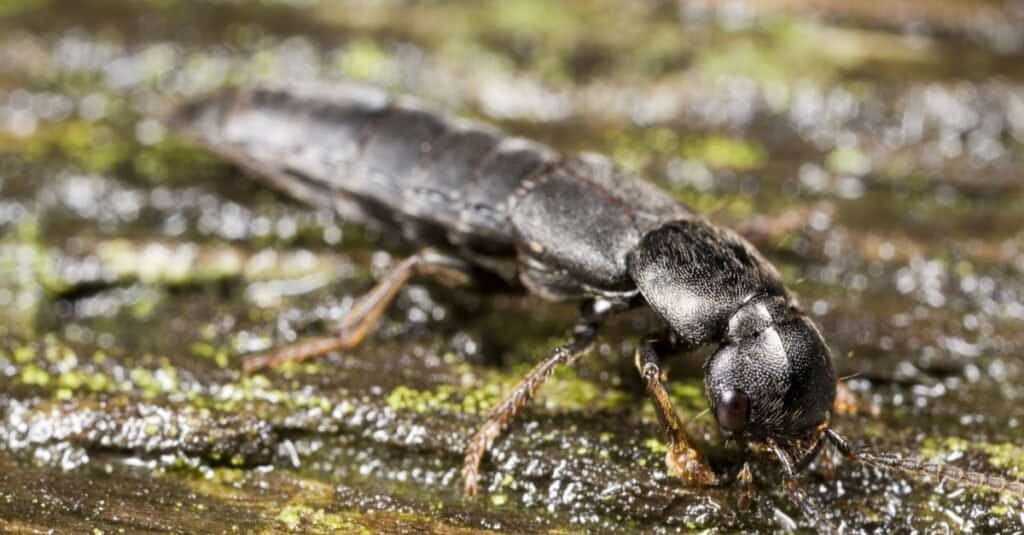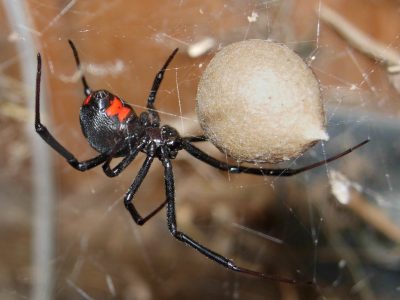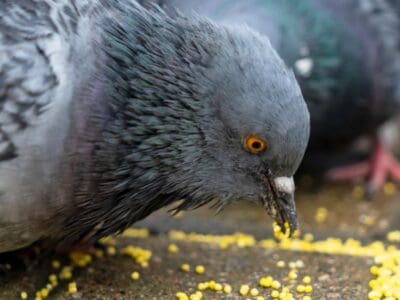Rove Beetle
When threatened, rove beetles raise the ends of their body like scorpions, but they have no sting.
Advertisement
Rove Beetle Scientific Classification
Read our Complete Guide to Classification of Animals.
Rove Beetle Conservation Status
Rove Beetle Locations

Rove Beetle Facts
- Prey
- Small insects
- Main Prey
- Fly larvae
- Name Of Young
- Larvae
- Group Behavior
- Solitary
- Fun Fact
- When threatened, rove beetles raise the ends of their body like scorpions, but they have no sting.
- Most Distinctive Feature
- Short elytron that covers less than half of their abdominal segments.
- Distinctive Feature
- Rove beetles raise their abdomen when startled
- Other Name(s)
- Charlie ant
- Habitat
- Rove beetles nest in decaying organic matter and soil.
- Predators
- Predaceous insects, reptiles and toads .
- Diet
- Omnivore
- Lifestyle
- Nocturnal
- Favorite Food
- Small insects and their larvae
- Type
- Beetle
- Common Name
- Rove beetles
- Special Features
- They can release a toxic chemical when threatened which can damage skin tissue
- Location
- Worldwide
- Nesting Location
- Under leaf litter, debris, rocks, and plants.
View all of the Rove Beetle images!
When threatened, the rove beetle will raise the ends of its body like a scorpion, but it has no sting or venom.
Summary
Rove beetles are a family of insects called Staphylinidae. The family contains thousands of species found in a variety of habitats all over the world. Rove beetles don’t have the ovoid shape that characterizes most beetles. They also have short elytra and are typically elongated, which makes them look like ants. Rove beetles have an interesting habit of raising the end of their bodies when they’re disturbed. However, they cannot sting or bite, but they do release a toxic chemical that can damage skin tissues. Although they have wings, beetles in this family prefer to run along the ground instead of flying.
Rove Beetle Species, Types, and Scientific Name
The name rove beetles refer to insects in the family Staphylinidae. This is one of the most diverse groups of beetles in the world. With more than 63,000 species, the family Staphylinidae is the largest family of any known organism.
Their common name is of English origin. The term rove means “to journey” or “move around,” especially with no specific destination. This refers to the tendency of this beetle to move around aimlessly. The rove beetle family consists of both living and extinct species. In fact, fossils of beetles in this family have been found in formations that date back to 200 million years ago during the Triassic period.
The rove beetle family is quite massive, and their classification has been controversial. Experts have proposed reorganizing the group into separate subfamilies and tribes. There are currently about 3200 genera, and up to 400 new species are described yearly. Many of the tropical species of this insect group are yet to be described.
Appearance: How To Identify Rove Beetles

Devil’s coach horse beetle, a kind of rove beetle. Superstitions hold that the devil takes the form of this beetle to eat sinners.
©Joseph Calev/Shutterstock.com
As expected for such a large family of insects, there are considerable variations in the size and appearance of the different species of beetles in the Staphylinidae family. However, most species are small (less than 3mm or ⅛ inch in length) and have elongated, slender bodies. The largest species of rove beetle, the devil’s coach horse, is as much as 25 mm (1 inch) long.
Unlike other beetles with a hardened wing cover that covers most of their body, Rove beetles are primarily distinguished by a short elytron that covers less than half of their abdominal segments. The short elytra protect a fully developed pair of wings that can unfold rapidly for flight. However, rove beetles rarely fly as they prefer to move quickly on the ground instead.
Rove beetles have an interesting habit of raising the tips of their abdomen like a scorpion when disturbed. Although they have no stingers, they release a foul-smelling fluid that can deter predators. Unfortunately, the liquid is also toxic if it comes in contact with human skin. It causes dermatitis (rash), serious skin irritation, or conjunctivitis if it comes in contact with the eyes.
There are major variations in the color and overall appearance of insects in this family. Some very large species are brightly colored. A mix of black and yellow is the most common, giving them a similar appearance to wasps. Some species also mimic soldier ants in terms of their appearance and behavior.
Habitat: Where to Find Rove Beetle
Rove beetles are found in terrestrial habitats worldwide. They are commonly found in outdoor habitats living under decaying leaves, wood, and other plant matter. You may also find them under stones and rocks.
Many species of rove beetles live in aquatic habitats. Many are found around freshwater margins, and up to 400 species live on the shores of oceans in areas commonly submerged by high tide.
Although rove beetles don’t form colonies, some species can live alongside ants and termites in their hives. They produce a fluid that the ants can eat. In turn, they’re fed by the ants. Some species also live in gardens in mutualistic relationships with humans. They help to get rid of fleas and other garden pests.
Diet: What Do Rove Beetles Eat?
Most species of rove beetle are insectivorous, although there are a few exceptions. A few species feed on live and decaying vegetation. In gardens, rove beetles are considered beneficial insects because they feed on small insect pests that destroy plants.
Both the adult and larvae forms of this beetle prey on insects. You may find adult beetles around decaying animal carcasses. They do not feed on the carcass but on the insects that feed on these carcasses. Some staphylinids are occasionally found feeding on small snails and slugs.
Because they feed on insects, several staphylinids have been introduced to locations they aren’t native to by humans. However, attempts to use them for the biological control of pests have not been as successful as expected.
What Eats Rove Beetles?
Predaceous insects, reptiles, toads, and birds may prey on rove beetles. The insect can fight back by releasing a toxic chemical from the tip of its abdomen. This is often enough to deter predators but might not always work.
Related Animals
View all 114 animals that start with RRove Beetle FAQs (Frequently Asked Questions)
Where are rove beetles most commonly found?
Rove beetles most commonly live in moist habitats. They are often found in the soil or near decaying organic matter. Although they do not feed on decaying flesh, they’re often found around carcasses because they feed on insects found on the carcasses. You may also see them under rocks, on plants, or in piles of decaying plants.
Are rove beetles dangerous?
No, they’re not. When threatened, rove beetles raise the tip of their abdomen like scorpions. However, unlike scorpions, they do not have a stinger and cannot bite. They do have a chemical defense mechanism to protect them from prey. They release a toxic fluid that helps to repel prey. This chemical is also released if the insect is squashed against the skin. This can damage skin tissues and leave you with a painful blister.
Where do rove beetles lay eggs?
Female rove beetles lay clusters of eggs near a potential food source for their larvae. Usually, they lay their eggs on rotten wood and other decaying plant matter. They also lay eggs in the soil near decaying animal matter, where there’s an abundance of fly maggots or larvae to feed on.
Thank you for reading! Have some feedback for us? Contact the AZ Animals editorial team.
Sources
- University of Florida, Available here: https://entnemdept.ufl.edu/creatures/misc/beetles/rove_beetles.htm
- Gardening Know How / Jackie Carroll, Available here: https://www.gardeningknowhow.com/garden-how-to/beneficial/rove-beetles-in-gardens.htm
- Wikipedia, Available here: https://en.wikipedia.org/wiki/Rove_beetle

















